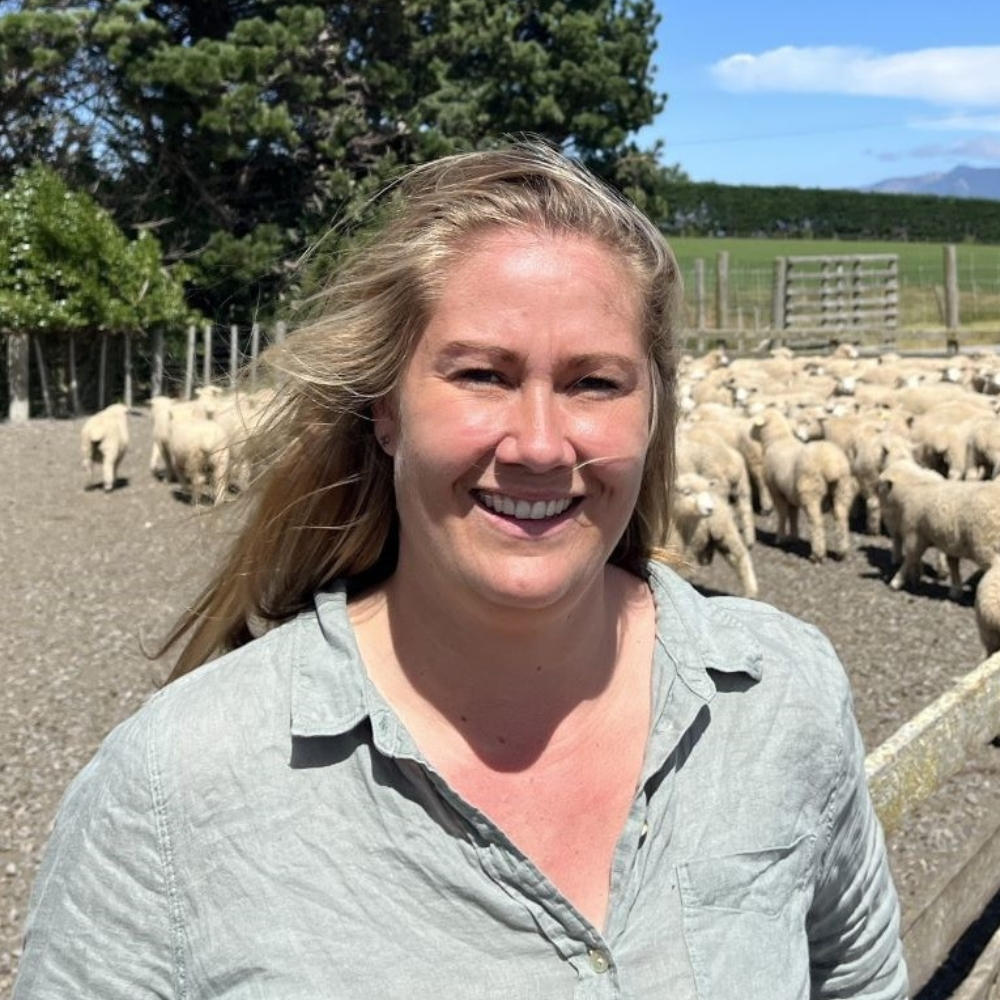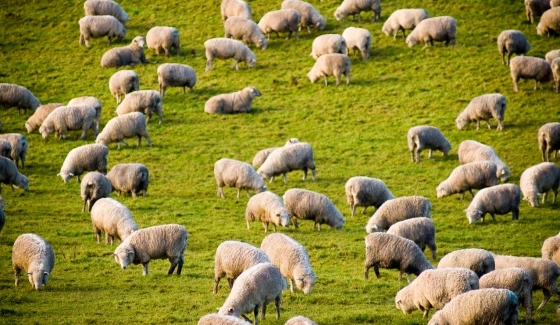
Genetic gain is the improvement made within the flock (or herd), genetically. At the base of it, genetics set the potential for an animal, and the environment helps to achieve the potential. By improving the genetics, we set that potential higher than it was for the previous generation.
In general, the average of the offspring should be equal to the average of the parents. That is, if you select the top 40% of ewe hoggets, their progeny should all average within that 40% range. In theory, by selecting their top 40% as the next generation, it will put the progeny in the top 16% of the initial parents. However, in practice, it is a little more complicated than that, with multiple generations contributing to the pool of replacements, multiple trait selection occurring, and environmental effects masking some of the genetic effects.
Heritability: what gets passed on to the next generation
Briefly, there are two aspects that make up the expression of a trait – genetics and the environment. The heritability of a trait indicates the amount of that trait that is influenced by genetics and passed on from one generation to the next. Environmental effects can range from temporary (were they first or last through the weigh crate on the day?) to permanent (born as a single in the first week of lambing versus as a triplet in the last week of lambing). Repeatability is how likely that trait is to be repeated next time it is measured.
Calculating genetic gain
Understanding each of the factors that determine genetic gain can help us accelerate our progress. Genetic gain is calculated using the selection intensity, accuracy of selection, and genetic variation within the population, all divided by the generation interval (see below). Increasing any of the first three will increase your genetic gain, as will decreasing the generation interval.
If you’re a visual learner, like I am, showing the difference on a standard bell curve really helps! Figure 1 shows the number of animals for a trait (e.g. weaning weight), within a normal distribution. We generally assume the base of the two axes is zero/the minimum measurement. The x axis shows the measurement (i.e. the weaning weight), and the number of times it occurs up the y axis. The mean (µ) sits in the middle of the bell, where more animals sit; while the extremes are where only a few animals sit. Without getting too into the maths behind it, 68% of the population will sit within one standard deviation (σ) either side of the mean, 95% within two standard deviations, and 99% within three standard deviations. The bell shape itself may be taller and skinnier, or shorter and fatter, but the principles still remain the same.

Selection intensity
Selection intensity is a derivative of the proportion of animals selected. In the example below (Figure 2), you can see the difference between selecting 300 replacement ewe lambs out of 750 total weaned (top 40% selected - orange) and selecting those 300 out of 1000 ewe lambs (including the lambs born to hoggets) (top 30% selected - yellow).

Selecting parents for the next generation from the top end of the range will move the population in that direction (and the further towards that top end the selection occurs, the faster the gains will happen). The limiting factor with ewes is that selecting females requires numbers, with plenty needed as replacements each year (25-40% of your ewe numbers, depending on the farm’s policy).
Rams, on the other hand, generally have a really high selection intensity. Assuming you were selecting from your own lambs, 1000 ewes require about 10 rams. If there were 750 ram lambs, with only 10 selected, you would be selecting the top 1.3%, right at the far end of the bell curve (blue section within the yellow curve).
Accuracy of selection
To actually achieve this selection intensity, you need accuracy of selection. How do you know that the rams you have selected are in the top 1.3%, or somewhere floating around in the middle?
Rams have the largest influence on the flock, due to the numbers of progeny they are producing. A ewe that isn’t within that top 40% (due to selection not being made accurately) will contribute 1-3 progeny per year, for a lifetime of 5 years. A ram on the other hand, mated to 100 ewes, weaning 140% will contribute 140 progeny PER YEAR for 3-4 years. Buying stud rams from farms that are recording multitudes of data is a great way to ensure the heavy hitters genetically are the best and are contributing positively to your flock. This is why it is important to understand the data going into your ram selections (another article to come).
So, how do you achieve accuracy of selection on a commercial farm? Generally speaking, in the strong-wool (or no wool) industry, your saleable product is lamb. There are two main factors that affect this: how many lambs are weaned per ewe mated, and how heavy are those lambs? Every farm will differ in this, and every farm will have their own sweet spot that achieves the best financial benefit. How you achieve that is up to you. But the common theme is: most product for least input.
So how does this trace back to accuracy? There are a few things that can be easily recorded to keep track of a ewe’s production, without necessarily needing a tag to record it:
- Birth rank and weaning weight: Using spray paint at scanning and keeping single-bearing ewes separate until weaning can identify the birth rank of the lambs. It is well established that birth rank (and rearing rank, but that is harder to identify in a commercial situation) affects weaning weight. Identifying birth rank - and having a different weight cut off for ewe lambs born as a single vs as a multiple - will help ensure you are not just selecting the biggest lambs at weaning (which are, as a majority, single-born). Because those born as a multiple are smaller at weaning due to their environment (and not genetics), a lighter twin might be genetically superior to a heavier single. Knowing the birth rank when making that selection decision will help to improve the accuracy.
- Number of lambs born (or weaned): Similarly, while the number of lambs born (or weaned) has relatively low heritability, it can be highly repeatable. Since heritability is low, there is a lot of environmental noise affecting the trait, and a single could merely be a blip in that ewe’s lifetime production. That doesn’t mean her daughter will be more likely to produce singles. But that ewe is much more likely to repeat this trait and produce a single again. You can identify those that are repeat offenders (producing only one lamb) with a tag or even a coloured cable tie in the ear, from year to year. Once a ewe hits two strikes, consider adding her to the terminal mob. Even with a low heritability, this selection can identify the lower producers and remove them from those that are contributing to the future gene pool of the flock.
The biggest gains here will be made through the selection of the rams. Even if selection within the ewe flock is random, progress can still be made by ensuring that ram selection is done with accurate data for the traits you are interested in.
Genetic variation in the population
Increasing the genetic variation in the population can also increase the rate of genetic gain. With more variation, the bell curve stretches out (Figure 3). Assume the middle of the curve has the same mean, and 1 kg of difference is the same distance across both x axes. Both assume a selection of the top 30% of your ewe hoggets, but the difference is that you might be looking at 3-4 kg difference between the top and bottom of your selection for a population that has low levels of genetic variation (left). However, that could be nearer to 10 kg of difference between the top and bottom of your selection with high levels of genetic variation (right).

The easiest way to introduce new genetics to the flock is to buy from a different ram breeder, be that within the same breed or by introducing a new breed. Introduction of a new breed can also introduce hybrid vigour, a phenomenon where the average of the progeny is better than the average of the parents.
Generation interval
The final part of the equation is to decrease the generation interval. The generation interval is the average age of the parents at the time the lambs are born. Decreasing the generation interval increases the speed at which the new genetics are passed on. If a replacement lamb is born to a 5-year-old ewe, she is passing on superior genetics from 5 years ago, whereas a replacement lamb born to a 2-year-old ewe has superior genetics from 2 years ago (which will be more superior than those from the 5-year-old ewe).
Reducing the average age of the parents creates a greater rate of turnover, which can lead to greater genetic gain. Be aware that with reduced age, there can be a reduction in the accuracy of selection, depending on the traits that are being measured.
There are a few ways to decrease the average age of the parents:
- Mate older ewes to a terminal (which removes their progeny from the selection pool for ewe replacements). Note, this will reduce the selection intensity, with fewer ewe lambs to select replacements from.
- Mate hoggets AND select replacements from their progeny. A common misconception is that merely mating hoggets will reduce the generation interval and increase genetic gain. If their progeny are all terminal, and were never considered as replacements, then this is not the case, as they are not parents of the next generation. You need to be actively selecting the replacements from hoggets for this to be true.
- Use younger rams. Again, since only a few rams (relative to ewe numbers) contribute to half of the genetics, the age of the rams used will have the greatest effect on the generation interval.
Selecting the right animals to make genetic progress in your flock
There are many factors that contribute to the rate of genetic gain, but as long as the trait is heritable, and there is genetic variation in the population, progress can be made by using the selection tools available. Influencing the selection intensity, accuracy of selection, genetic variation and generation interval are the main ways to increase rates of genetic gain. With a bit of understanding about how it works, you can make small decisions on-farm to influence the genetic gains you see in your flock.
-----
Join the conversation on The Hub
Take a moment to head over to the neXtgen Agri Hub and share your thoughts on making genetic gain.




.jpg)




